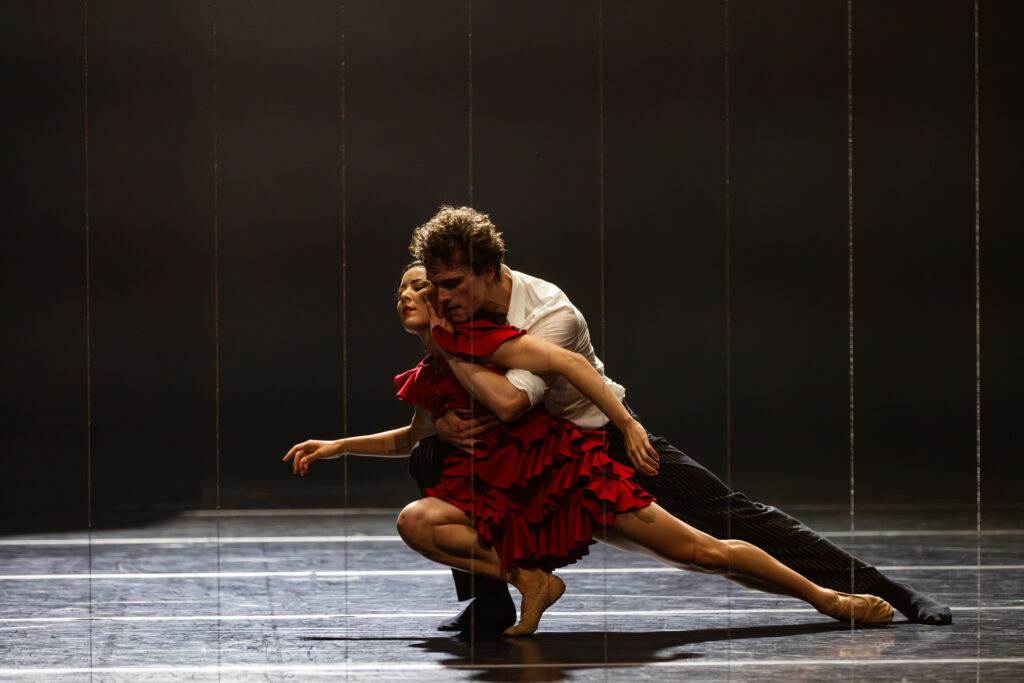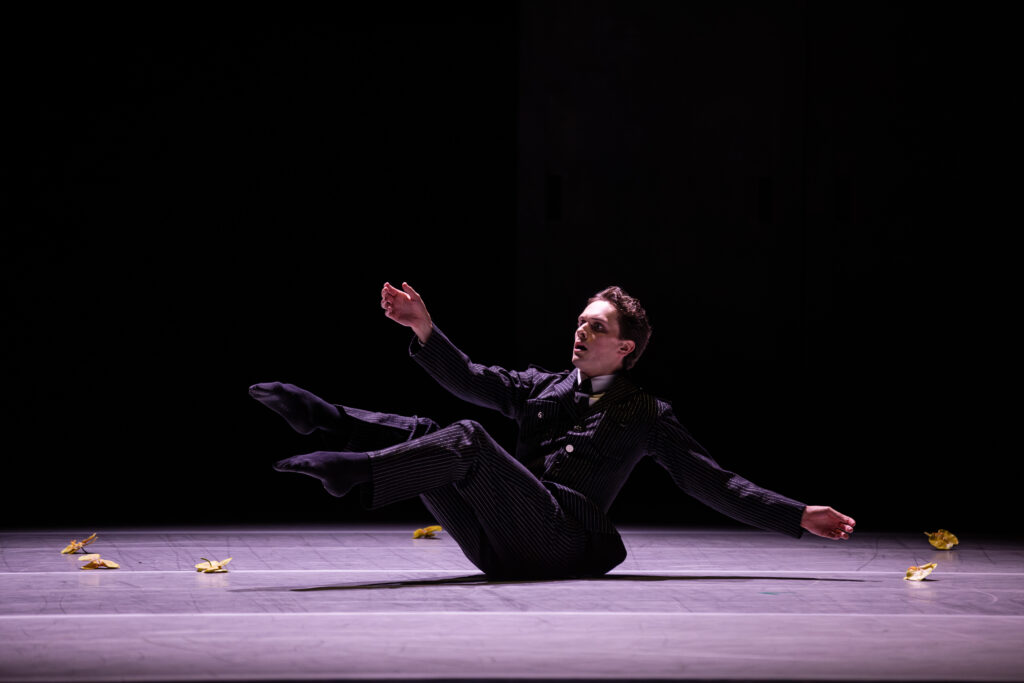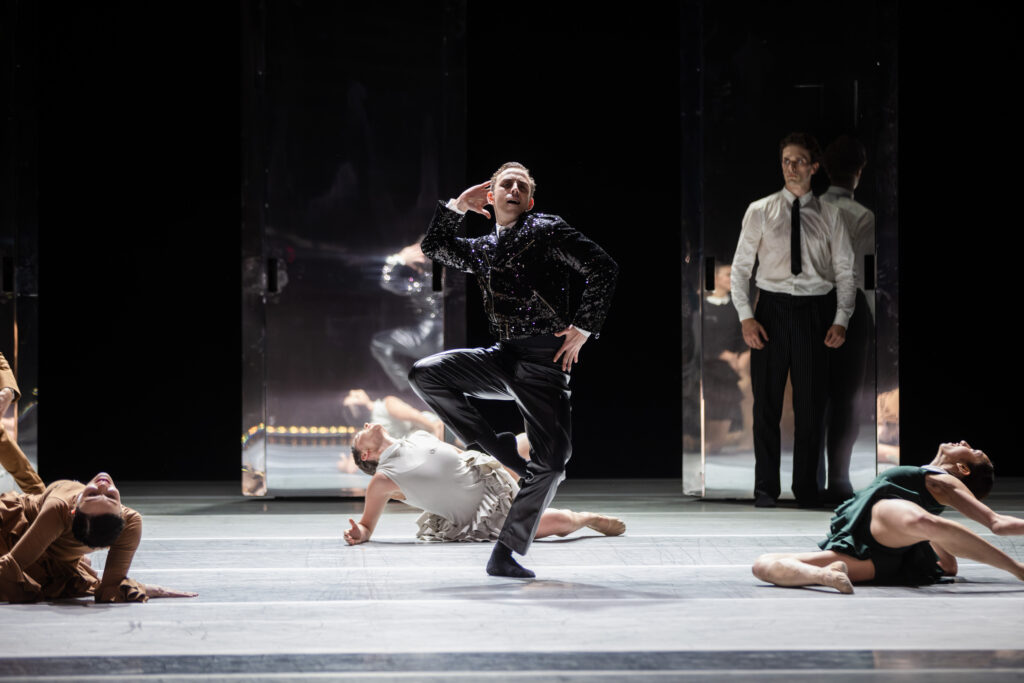Johan Inger’s Carmen is yet another triumph for The Australian Ballet under Artistic Director David Hallberg.
Following the success of Kunstkamer, it proves beyond doubt that our dancers can take signature works of other companies and make them their own (or better).
That may seem a bold claim, but last night’s performance of Carmen is as good as any seen around the world, with some performances surpassing those that have gone before.

Jill Ogai and Callum Linnane in The Australian Ballet’s production of Johan Inger’s Carmen. Photo © Daniel Boud
Others have certainly succeeded at creating the playful unease that quickly gives way to violence, but few could match the emotive force of Jill Ogai and Callum Linnane’s visceral performances.
As Carmen, Ogai (recently promoted to Principal Artist) is the perfect embodiment of the woman who will always be free, and whose principles defy convention, confounding the men who try to ensnare her.
What makes Ogai’s performance truly remarkable is her chameleon-like ability to blend in with the rest of the tobacco workers, underlining the indiscriminate way men see them as mere sex objects devoid of personality, before she emerges from the crowd and dominates the stage with her steely determination.
It’s a bravura performance, Ogai giving us a Carmen who is confident in her sexuality and owns it, unlike Callum Linnane’s sexually frustrated Don José.
Linnane was born to dance the choreography of Johan Inger. This was already evident when he performed the role of Spencer in a one-off performance of Inger’s I New Then at the Sydney Opera House in 2022.
Whereas Spencer’s sexual awakening was joyous, Don José’s was evidently steeped in trauma. Linnane brilliantly captures this, seamlessly moving from childlike abandon to awkward naïvete and contorted anguish in one of the most exciting dance performances seen on the Joan Sutherland Theatre stage in ages.
Supple one moment, rigid and angular the next, he understands Inger’s vocabulary and runs with it, expressing himself through movements and gestures that could belong to Nijinsky, Forsythe or even Ron Lewis.
They’re all Inger, who is never derivative but totally in command of the language and history of dance. How thrilling to experience the work of a choreographer who expands the lexicon without feeling the need to rewrite it or throw it out altogether.

Callum Linnane in The Australian Ballet’s production of Johan Inger’s Carmen. Photo © Daniel Boud
Of course, there are nods to Jiří Kylián; after their years together at Nederlands Dans Theater how could there not be? The frequent comparisons commentators make to Mats Ek are also justified, while the rawness of the barefooted tobacco workers recall Louise’s Ballet from Carousel by Agnes DeMille, at least for this writer.
It all adds to the rich palette Inger employs, not only in Carmen, which is his first narrative ballet created in 2015, but in his later works too. And while one can easily take his treatment of Mérimée’s 1845 novella on face value, there is more at play for those who seek to find it.
Just as Inger’s Don Juan and Swan Lake explore commitment issues and intergenerational trauma, so Carmen delves into the psyche of Don José, not as an apology for his abusive and murderous tendencies, but to develop his personality beyond that of simply the ‘jealous lover’.
We see how inept he is, cowering like a wallflower and trying in vain to look away while the company dances and sings the Toreador Song. The torero, danced with panache by Marcus Morelli, is every bit the man Don José wishes he could be.
So too, his commanding officer, Zúñiga (Brett Chynoweth) has all the masculine authority he lacks. His despatching of Zúñiga is one of several moments of choreographic genius and sees a prostrate Chynoweth carried away on a wave formed by dancers in black – the ‘shadows’ in Don Jose’s mind.
The Second Act plunges us into the nightmare world of Don Jose’s delusional state, in which he plays happy families with Ogai and Lilla Harvey as the Boy. On paper, the Boy is a contemporaneous character who occupies the same world as the other characters, watching and judging them. However, he could just as easily be a young Don José, in keeping with Inger’s psychoanalytical treatment.
Don José’s dream world is shattered when his rage gets the better of him (or is it the suppressed memory of domestic violence in his own childhood) and he slumps to the floor as the preening torero returns to seduce Carmen.
Ogai and Morelli are superb in this erotically charged pas de deux set to the Habanera. Just who is leading whom is unclear as they take turns in the traditionally male partner role.

Marcus Morelli and artists of The Australian Ballet in Johan Inger’s Carmen. Photo © Daniel Boud
Inger’s decision to combine Shchedrin’s arrangement of Bizet’s opera (written in 1967 for the composer’s wife, Bolshoi prima ballerina Maya Pilsetskaya) with additional selections from Bizet arranged by Álvaro Domínguez Vázquez and contemporary music by Marc Álvarez is inspired.
The rapid cuts from one style of music to another underpin the transitions between reality and Don Jose’s delusions. It is reminiscent of the contrasting use of Mendelssohn’s Romantic score and Ligeti’s electronic music to move in and out of the dream state in John Neumeier’s A Midsummer Night’s Dream – another favourite of this writer.
At the time of writing his Carmen Suite, Shchedrin said that a ballet orchestra should sound “a few degrees ‘hotter’ than the operatic.” The Opera Australia Orchestra led by Acting Concertmaster Huy-Nguyen Bui does just that, delivering a superb reading of the score under Daniel Capps and accentuating the stifling atmosphere of Inger’s ballet.
Curt Allen Wilmer and Leticia Gañán’s set design, comprising triangular prisms wheeled around the stage by the dancers, effectively create three ‘worlds’: the Brutalist outdoors; the interior of the factory with its lockers; and the mirrored, introspective world of Don José.
The lighting by Tom Visser supports the changes in musical style, ensuring we are never at a loss as to which of these worlds we are in, while the costume design by David Delfín and his design associate Maria Luisa Ramos set it all off with a Hispanic ruffle, caring more about function than aesthetic flourishes – and that’s all it needs to do.
There is something very satisfying about watching great artists get it right. According to Hallberg, Inger asked the dancers to find “the humanness between ugliness and beauty”.
They succeeded with flying colours, and while the picture may not be pretty, this writer can’t wait to see it again.
The Australian Ballet presents Carmen at the Sydney Opera House until 27 April.











Comments
Log in to join the conversation.